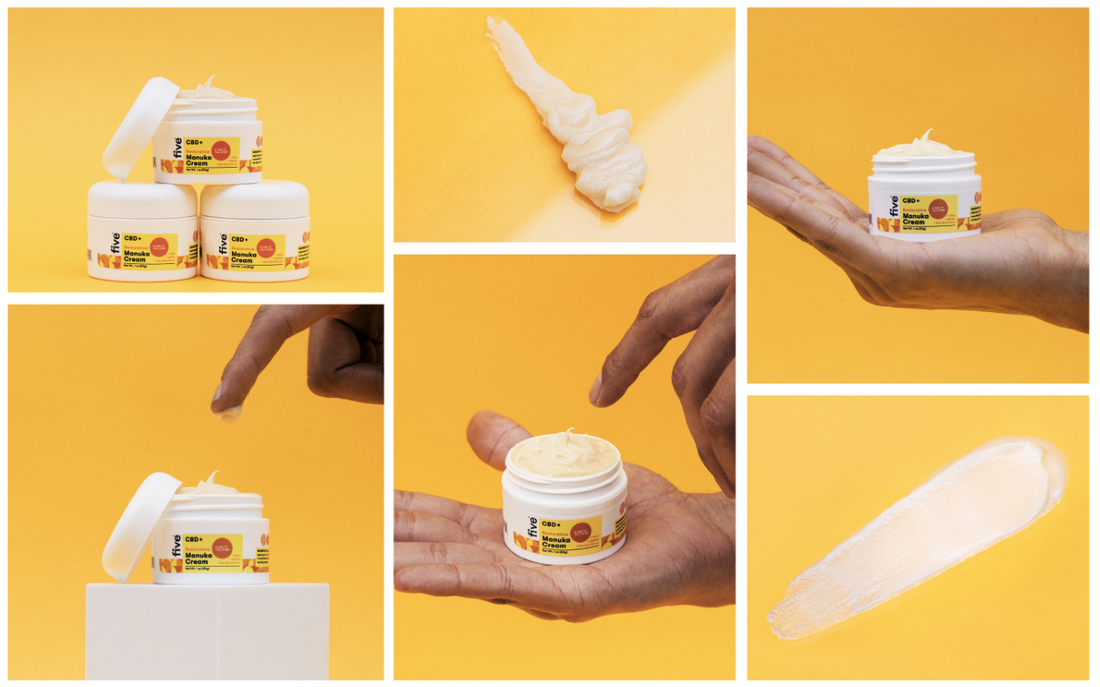- news
- what are cbd topicals? how cbd is absorbed through the skin
What Are CBD Topicals? How CBD Is Absorbed Through the Skin
06.15.2022 | Reading Time:Written by: Loren Baker

Share
Looking for pain relief? Faster recovery from workouts? Improved mobility? The perfect complement to your next massage session?
If you answered yes to any or all of the questions above, CBD topicals might just be for you. Keep reading to learn how CBD topicals work their magic.
- CBD topicals 101
- How do CBD topicals work?
- The wild history of CBD topicals
- 4 things to look for in a CBD topical
CBD topicals 101
Before getting into the many benefits of CBD topicals, we should probably zoom out a little and look at what they are in the first place. A CBD topical is just a topical cream, salve, skincare product, etc. that's been infused with CBD.
In other words, CBD topicals come in all shapes and sizes, with their only definitive quality being that they contain CBD.
CBD topicals are among the most popular kind of CBD products. Interestingly enough, archaeological evidence implies that they're also one of the oldest.
Whether we're talking about a thousand-year-old hemp-derived CBD paste or a modern CBD skincare tincture, though, CBD topicals are known for their ability to dampen certain inflammatory pathways and reduce discomfort. More on how all this works coming up next.
How do CBD topicals work?
Let’s start off with the basics: virtually any type of CBD product, whether edible or topical or even injectable, works by activating the human body's built-in endocannabinoid receptors. In the case of CBD topicals, endocannabinoid receptors located throughout the dermal tissue (i.e. the skin) get activated and confer localized effects. CBD topicals may also activate the very same TRPV1 receptors that allow your body to sense pain. [1]
Translation? Putting a CBD topical on your elbow won't result in CBD getting into your bloodstream or circulating throughout your entire body. And that's okay — it probably will result in a less achy, more mobile elbow area.
The wild history of CBD topicals
As we mentioned above, CBD topicals might just be the original hemp-derived product. Ancient iterations of these topicals, often derived from crushed hemp seeds or high-CBD kief, have been found everywhere from India to Egypt.
As cannabis expert and neurologist Dr. Ethan Russo States in his excellent article, “History of cannabis and its preparations in saga, science, and sobriquet,” it’s thought that these preparations were used to relieve glaucoma, chronic swelling, and acute injuries. Whether we’re talking about old CBD topicals or new ones, the applications are nearly endless! [2]
4 things to look for in a CBD topical
But let's not get ahead of ourselves here. While CBD topicals can indeed be super effective, not all of them are created equal. Below are four of the most important factors to consider before buying a topical product. (Keep in mind that these aren't the only qualities to consider, just some of the most relevant ones.)
- Full spectrum CBD
- A good base
- Healthy fats
- Extra ingredients
Full spectrum CBD
First things first: the best CBD topicals are virtually always powered by a full spectrum CBD extract. Without full spectrum CBD, nothing else about a CBD topical really matters.
(Need more info about full spectrum CBD? Click here to learn more about its superiority over other types of CBD.)
A good base
If you've managed to find a CBD topical that contains truly full spectrum CBD, congrats — you're off to a good start. But that's not all you should expect from a truly high-quality product. Some topicals pair clean CBD with less than ideal oils and emulsifiers.
Given that these additives have been shown to activate the very same inflammatory pathways that CBD may be able to quench, that's kind of counterproductive…isn't it?
Be sure to find a product that combines high-quality CBD with a high-quality, natural, non-inflammatory base. Good options include Shea butter, cocoa butter, jojoba oil, or even hemp seed oil.
Healthy fats
To expound on the previous recommendation a little bit more, some bases are better than others. And even topicals that seem to have high-quality bases at first glance may be cut with lower-quality oils.
These oils, which include grapeseed oil and/or canola oil, are used by some companies to cut costs. The only problem is that they're terrible for your skin. When it comes to topical application, saturated fats and oils are actually best. The more saturated an oil is, the more resistant it is to being oxidized by UV light, oxygen, and other would-be offenders. [3]
Extra ingredients
Last but not least, consider evaluating any CBD topical you're interested in by whether or not it contains anything else besides CBD. Prime additions include things like aloe vera, cacao, sea buckthorn oil, and honey.
Yes, you heard that right — honey! It turns out that manuka honey perfectly complements CBD.
Why put honey onto your skin? A better question might be, why wouldn't you put it onto your skin? Manuka honey has been shown to have anti-inflammatory, anti-irritative antioxidant, pH-balancing, and hydrating effects. And these benefits are just the start.
Summing things up
CBD topicals make feeling better simple. They may not be the end all-be-all…but they are incredibly effective when it comes to resolving aches, pains, and various discomforts. Especially if you opt for a topical that combines CBD with nature’s other highlights!

